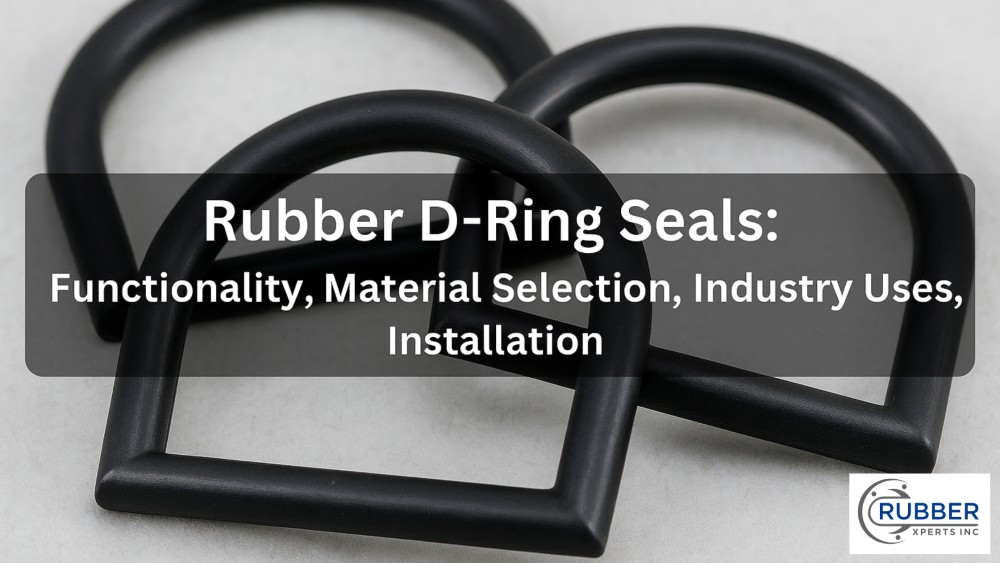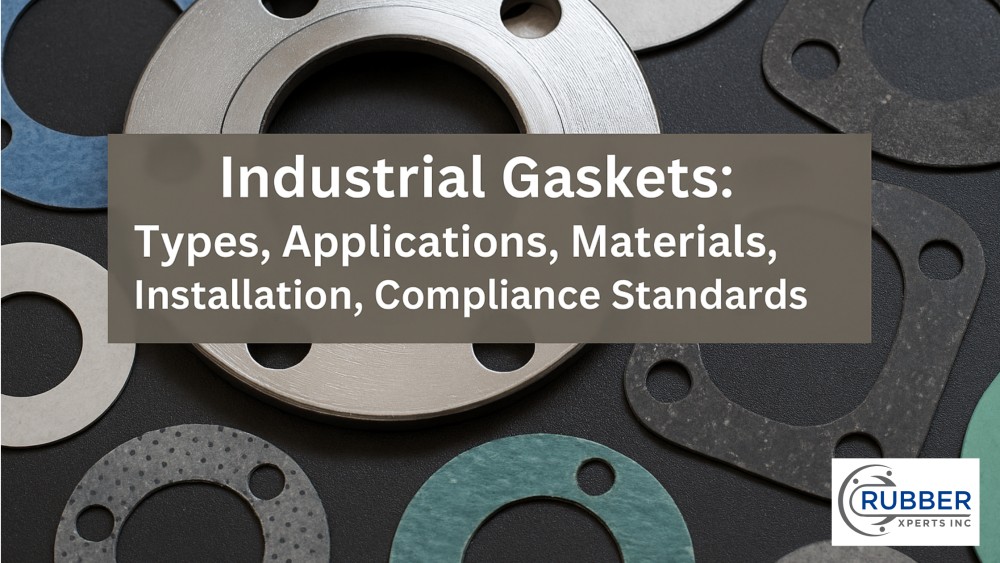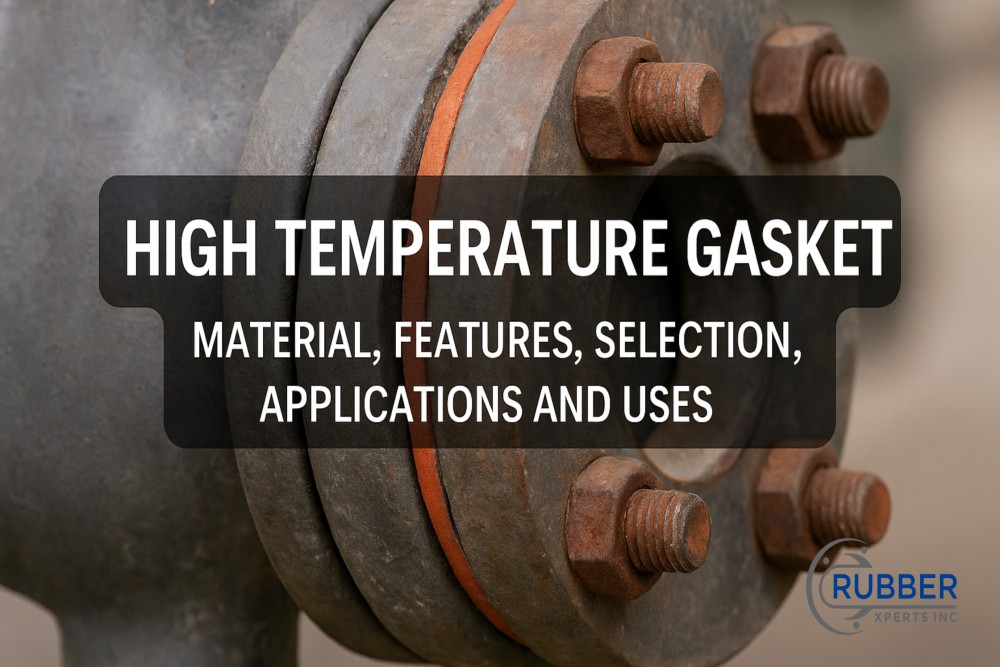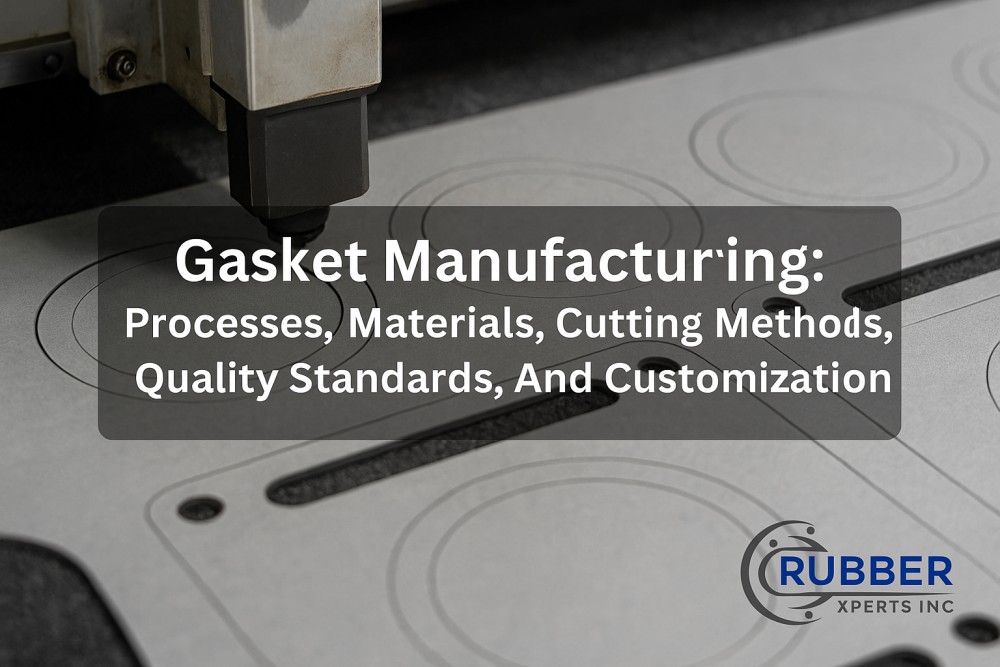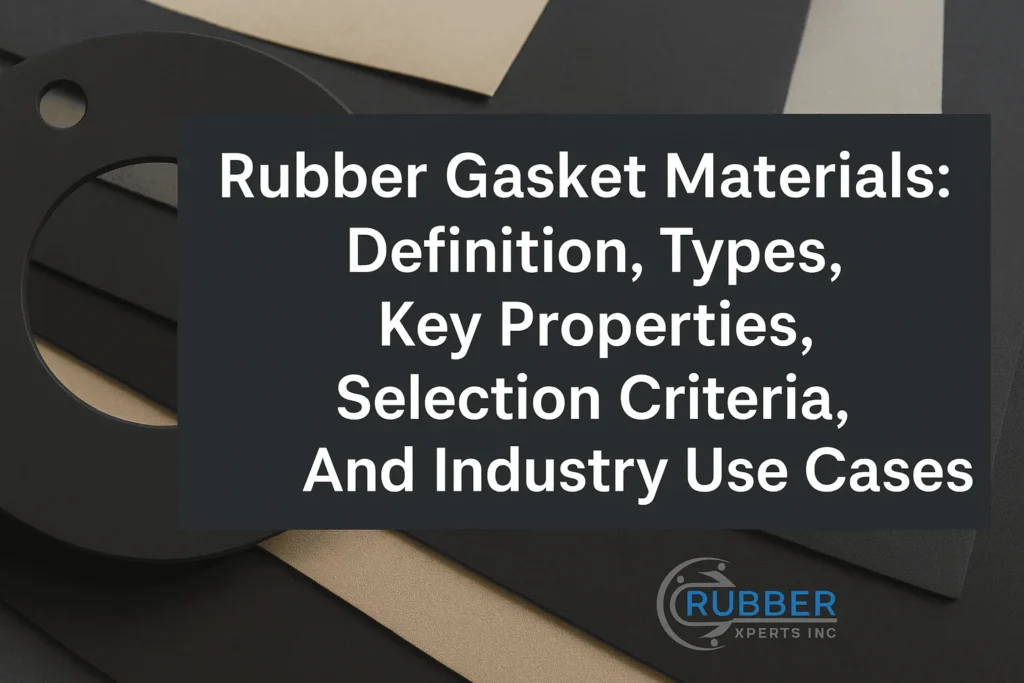Silicone rubber gaskets protect and stabilize connections across various industrial, medical, and food systems. As a flexible sealing material, they absorb pressure, resist thermal stress, and prevent fluid or gas leakage under demanding conditions.
Silicone rubber gaskets play a vital role in industrial systems by providing temperature-resistant sealing, pressure resistance, and insulation. These gaskets prevent system failure and leakage.
The silicon gasket retains heat within systems and blocks external thermal intrusion. It supports consistent performance in both heated and cooled environments.
Food-grade silicone complies with safety regulations for direct food contact. It prevents contamination in mixers, valves, and packaging lines.
Medical-grade gaskets are designed for resistance to sterilization and to ensure patient safety. They enable clean integration in pumps, ventilators, and lab instruments.
High-purity sealing eliminates the risk of chemical leaching or particulate release. It is important for cleanrooms, biotech labs, and pharmaceutical environments.
Industrial sealing applications operate under oil, pressure, and dynamic stress without breakdown. They are applied in engines, pumps, and processing systems.
Gasket technology utilizes specialized compounds for targeted performance. It enhances reliability in vibration damping, thermal sealing, and chemical protection.
What Is A Silicone Rubber Gasket?
The Silicone Rubber Gasket is a rubber-based sealing component made from silicone polymer, used to block the passage of fluids or gases between two surfaces. It serves as a flexible gasket, maintaining its form across extreme temperature changes, mechanical loads, and environmental stress.
This soft sealing gasket is composed of synthetic rubber derived from silicon, oxygen, carbon, and hydrogen. Its non-reactive material structure prevents degradation when exposed to chemicals, oils, and UV radiation, enabling longer service life.
The gasket composition provides a versatile sealing solution for industries that require thermal stability, electrical insulation, and dimensional resilience. Due to its elastomer seal behavior, it adapts to surface irregularities, delivering an airtight or watertight fit.
As a chemical-resistant seal, silicone rubber gaskets serve high-precision needs where conventional gaskets fail. This sets the context for analyzing their properties, applications, and performance benefits.
What Are The Properties Of Silicone Rubber Gaskets?
The properties of silicone rubber gaskets are resilience, resistance, insulation, color and grade variability, and thermal stability. These properties arise from the gasket’s inert material composition and its design as a non-toxic material suitable for demanding environments.
The properties of silicone rubber gaskets are explained below:
1. Resilience
Resilience is the ability of silicone rubber gaskets to return to their original shape after deformation. This elasticity ensures continued sealing even after repeated compression or mechanical stress.
According to a study by M. Joshi and B.S. Butola titled “A Review on Specialty Elastomers Based Potential Inflatable Structures and Applications”, published in Advanced Industrial and Engineering Polymer Research (2021), silicone rubber exhibits a compression set resistance of under 25% after 22 hours at 177°C, indicating long-term dimensional stability.
The gasket’s compression set resistance maintains sealing force over extended periods. This reduces the risk of leaks in systems exposed to vibration, load shifts, or pressure cycles. Maintaining dimensional integrity under load is critical for sealing reliability. Resilience prevents material fatigue, reduces maintenance needs, and improves operational safety.
2. Resistance
Resistance in silicone rubber gaskets refers to their ability to endure harsh environmental and chemical exposure without material breakdown. This includes UV resistance, ozone resistance, and chemical stability, which protect the gasket from surface cracking, degradation, and loss of sealing performance.
Exposure to oils, acids, oxidizers, and extreme weather does not compromise the inert material composition of silicone. This prevents swelling, embrittlement, or corrosion, even after prolonged use in demanding conditions.
The benefit lies in maintaining consistent sealing under external chemical or atmospheric pressure. This increases the service life of silicone rubber gaskets and reduces replacement frequency across industries exposed to corrosive agents.
3. Insulation
Insulation in silicone rubber gaskets refers to the material’s ability to resist electrical conductivity. This is defined by high dielectric strength, which prevents electrical flow and breakdown when exposed to voltage stress.
The inert material and uniform cross-linked silicone structure create a stable barrier that maintains electrical isolation. This enables use in enclosures, cable seals, and high-voltage components where insulation reliability is required.
Rubber insulation provides critical protection against arc faults, electrical leakage, and short circuits. This ensures operational safety in electronics, aerospace controls, and power transmission assemblies.
4. Color And Grade Variability
Color and grade variability in silicone rubber gaskets refers to the ability to manufacture them in multiple color codes and material grades based on application needs. This allows easy identification, compliance marking, and compatibility with regulatory or industry-specific standards.
Silicone’s non-toxic material base supports pigmentation without altering chemical stability or moisture resistance. Grades are formulated for medical, food-grade, high-strength, or flame-resistant purposes, depending on system requirements.
This customization enhances traceability, safety, and functional precision. Color-coded elastomer seals minimize installation errors, while tailored grades meet certification requirements across various sectors, including pharmaceuticals, aerospace, and food processing.
5. Thermal Stability
Thermal stability refers to the ability of silicone rubber gaskets to maintain their mechanical and chemical integrity across a wide range of temperatures. The gasket composition remains flexible and non-deforming from as low as 60°C to above +230°C in standard formulations.
This property arises from the silicone polymer backbone, which resists thermal breakdown. Enhanced temperature resistance ensures optimal performance in both cryogenic and high-heat environments, without compromising sealing capacity or undergoing hardening or melting.
Thermal reliability reduces system failure in engines, ovens, refrigeration units, and aerospace compartments. Consistent sealing prevents leaks and deformation, ensuring durability across extreme thermal cycles.
What Are The Applications Of Silicone Rubber Gaskets?
The applications of silicone rubber gaskets include aerospace, automotive, electronics, electrical, medical, and food processing industries. These use cases rely on the material’s temperature resistance, chemical stability, and non-toxic material profile to maintain performance in sensitive or high-stress environments.
The applications of silicone rubber gaskets are as follows:
1. Aerospace
In aerospace systems, silicone rubber gaskets act as thermal and vibration seals for high-performance aerospace components. These include engines, actuators, pressure panels, and avionics. The gaskets serve as elastomer barriers against high-altitude stress, thermal cycling, and mechanical shock.
Silicone gaskets are installed in access doors, control panels, duct joints, and airframe interfaces. Their ozone resistance, compression set resistance, and temperature resistance maintain sealing without cracking or distortion. The material supports flexible sealing even at temperatures as high as 60°C and over 230 °C in flight environments.
Product examples include jet engine thermal insulation seals, fuselage vibration mounts, cockpit panel gaskets, and fuel valve liners. Silicone rubber forms soft interfaces in pressurized cabins, hydraulic seals, and flame barriers in turbine zones.
These applications demand consistent pressure retention, heat shielding, and resistance to inert fluids. The gasket composition preserves mechanical alignment while absorbing vibration and compensating for joint movement.
2. Automotive
In automotive systems, silicone rubber gaskets function as automotive sealing elements for high-temperature, fluid-exposed engine and chassis components. The gaskets maintain joint integrity under mechanical load, oil contact, and thermal expansion.
They are placed in engine covers, valve bodies, intake manifolds, thermostat housings, and electric vehicle (EV) battery modules. The material’s chemical stability, moisture resistance, and temperature resistance prevent leakage and deformation under heat and pressure cycles.
Common products include gasket seals in turbochargers, transmission panels, coolant connectors, oil pan flanges, and HVAC system interfaces. The rubber-based sealing ensures long-term dimensional stability, even in the presence of lubricant exposure and vibration.
Silicone supports noise isolation, thermal barrier function, and sealing flexibility in automotive electronics and under-hood compartments. The gaskets allow tolerance absorption in moving joints, supporting emission controls and powertrain insulation.
3. Electronics & Electrical
In electronics and electrical systems, silicone rubber gaskets provide sealing and insulation for electronics enclosures, connectors, and circuit housings. These gaskets isolate sensitive components from moisture, dust, and electromagnetic interference.
They are installed in switchgear, PCB casings, LED drivers, control panels, and high-voltage terminals. The material’s dielectric strength, flame-retardant properties, and non-toxic base allow for safe use in both consumer and industrial devices.
Products include gaskets in lighting enclosures, junction boxes, electrical meters, and sensor housings. Silicone gaskets provide contact protection and ensure enclosure sealing in varying humidity and voltage conditions.
The elastomer prevents contact corrosion, tracks heat flow, and supports electrostatic shielding. These properties preserve signal integrity and structural isolation in mission-critical electronics.
4. Medical
In medical systems, silicone rubber gaskets function as sterile barriers in fluid-transfer, respiratory, and diagnostic medical devices. These gaskets prevent contamination, leakage, and deformation in equipment exposed to temperature variation and sterilization cycles.
They are used in oxygen concentrators, infusion pumps, surgical instruments, and diagnostic cartridges. The material’s non-toxicity, chemical stability, and moisture resistance enable safe contact with biological fluids and sterilizing agents.
Examples of products using silicon rubber gaskets include seals in ventilator tubing, diagnostic analyzer housings, dialysis ports, and imaging device enclosures. Silicone’s inert material structure prevents leaching, odor transfer, and microbial colonization.
These gaskets enable repeat sterilization, ensure biocompatibility, and maintain barrier function during long-term use. The elastomer structure supports precision in sealing without risk of residue or immune response.
5. Food Processing
In food production systems, silicone rubber gaskets act as sanitary seals in food processing equipment where hygiene, temperature exposure, and chemical contact are present. These gaskets maintain safe sealing during cleaning cycles and thermal shifts.
They are placed in mixers, pasteurizers, filling valves, pipe joints, and pressure vessels. The material’s non-toxic properties, flame retardant characteristics, and chemical stability prevent contamination and material degradation under CIP and SIP procedures.
Silicon rubber gasket product examples include gaskets in dairy separators, beverage filters, baking ovens, and liquid dosing pumps. The rubber-based sealing allows for flexible sealing between metal interfaces in contact with food.
The gaskets reduce bacterial retention, preserve product purity, and support FDA-compliant systems. Their resistance to oils, acids, and steam makes them reliable in continuous production cycles and cleanroom environments.
What Are The Temperature Ranges Of Silicone Rubber Gaskets?
The temperature ranges of silicone rubber gaskets are –60°C to +230°C for standard use, –100°C for low-temperature environments, and up to +300°C for high-heat applications. These values define the operating temperature range across sectors requiring precise thermal sealing.
The temperature ranges of silicone rubber gaskets are explained below:
Standard Range -60°c to +230°c
The standard temperature range of 60°C to +230°C defines the operating temperature range for general-purpose silicone rubber gaskets. This range supports performance under moderate heat and cold conditions without compromising elasticity or seal integrity.
This level of temperature stability enables use in automotive engines, electronics, and food processing lines. Gaskets remain dimensionally consistent despite temperature fluctuations, preventing leak paths or structural failure during thermal cycling.
The silicone heat tolerance within this range resists degradation from sustained heat, while the extreme cold tolerance prevents hardening in refrigerated or outdoor environments. The material supports insulation in systems with both ambient and heated fluid flow.
The thermal endurance of this category strikes a balance between flexibility and sealing efficiency, making it suitable for multi-industry use where environmental conditions vary but do not exceed extreme thresholds.
Low Range -100°c
The low-temperature range, reaching –100°C, defines extreme cold tolerance for silicone rubber gaskets in sub-zero environments. This level supports function in cryogenic and high-altitude applications where most elastomers fail.
Silicone maintains its flexibility and temperature stability without embrittlement at this depth, allowing for continued sealing in aerospace fuel systems, freezers, or devices used in arctic climates. The gasket’s thermal insulation prevents heat loss and moisture penetration in vacuum or frost exposure conditions.
This operating temperature range eliminates the risk of fracture during startup in frozen conditions. The ability to recover shape under mechanical stress at –100°C extends durability in cold-chain systems and satellite interfaces.
The benefit of this range lies in its long-term thermal endurance under freezing stress, allowing for installation in aviation controls, cryogenic storage units, and outdoor sensor housings that require both flexibility and a heat exposure rating below freezing.
High Range +300°c
The high temperature range, which reaches +300°C, provides high heat resistance for silicone rubber gaskets in elevated thermal environments. This rating supports prolonged exposure to engine heat, industrial ovens, and sterilization chambers without deformation.
At this level, the gasket retains elasticity and temperature stability, protecting against hardening, cracking, or seal loss during extended heat exposure rating cycles. The silicone heat tolerance prevents thermal fatigue and preserves sealing under static and dynamic loads.
Applications include turbine casings, exhaust systems, food sterilizers, and autoclaves. In these settings, the material’s thermal endurance resists oxidation and chemical breakdown under consistent high-temperature operation.
This range ensures safe performance in systems where temperature fluctuations occur rapidly or stay consistently above 250°C. It supports safety, reduces maintenance, and extends material longevity under continuous thermal stress.
What Are The Average Temperature Ranges By Gasket Material Type?
The average temperature ranges by gasket material type identify the specific operating temperature range each elastomer or composite gasket endures under industrial conditions. This comparison highlights the thermal insulation, heat exposure rating, and temperature stability across various gasket formulations.
The table below outlines each gasket material and its respective silicone heat tolerance or equivalent range, providing a guide for thermal performance selection across sealing applications.
| Material Type | Temperature Range (°C) |
| Silicone | -100 to +300 |
| Nitrile (Buna-N) | -40 to +120 |
| EPDM | -50 to +150 |
| Neoprene | -40 to +120 |
| Viton (FKM) | -20 to +250 |
| Natural Rubber | -50 to +90 |
| PTFE (Teflon) | -200 to +260 |
| Graphite | -200 to +500 |
| Non-Asbestos | -100 to +250 |
| Cork Rubber | -20 to +120 |
What Are The Performance Benefits Of Silicone Rubber Gaskets?
The performance benefits of silicone rubber gaskets are their ability to withstand high and low temperatures, provide excellent insulation, maintain high durability, comply with FDA safety standards, offer reliable compression set resistance, exhibit low flammability, and repel water. These attributes ensure reliable sealing, long service life, and stable performance in harsh environments.
The performance benefits of silicone rubber gaskets are as follows:
1. Withstand High And Low Temperatures
Silicone rubber gaskets provide reliable sealing across a wide temperature range, from –100°C to +300°C. This range allows operation in both cryogenic systems and high-temperature industrial machinery without compromising gasket integrity.
Their superior elasticity remains intact even under extreme thermal shifts, preventing material fatigue or leakage at sealing points. This resistance ensures uninterrupted function in HVAC units, turbine housings, food processing equipment, and outdoor enclosures.
Withstanding both heat and cold provides a long service life, lowers replacement frequency, and supports maintenance-free sealing. The gaskets stay flexible under pressure, even in zones with rapid thermal cycling or exposure to direct flame and freezing air.
2. Excellent Insulation
Silicone rubber gaskets offer high dielectric strength, enabling effective electrical isolation in power systems and electronic devices. This excellent insulation capacity protects components from arc discharge, leakage currents, and electrical shorts.
Used in control panels, switchgear, and sensor housings, the gasket maintains reliable sealing while blocking conductive pathways. This ensures safety in live environments and precision in signal-sensitive equipment.
The insulating property contributes to weatherproof performance and safeguards operational continuity in electronics enclosures exposed to moisture, vibration, or voltage fluctuations.
3. Highly Durable
Silicone rubber gaskets provide a durable sealing solution due to their resistance to wear, fatigue, and environmental degradation. Their low compression set and superior elasticity preserve sealing force over time without permanent deformation.
They remain stable in harsh environments, including those with chemical exposure, UV radiation, and mechanical vibration. This durability ensures long sealing intervals in engines, cleanrooms, and industrial machinery.
High durability reduces system failures, supports maintenance-free sealing, and extends the long service life of both the gasket and the equipment it protects.
4. FDA Approved
Silicone rubber gaskets are certified as a non-toxic material for repeated use in food-contact environments. The FDA has classified silicone under 21 CFR 177.2600, allowing its use in systems where sealing interfaces come into direct contact with food and beverages.
According to the U.S. Food and Drug Administration, in the regulation titled “Title 21, Code of Federal Regulations §177.2600 – Rubber articles intended for repeated use,” 2023, silicone elastomers are approved for use in repeated food contact applications, provided they comply with specified extraction limits.
This approval supports use in food processing equipment and pharmaceutical manufacturing, where chemical stability and weatherproof performance are important. The material does not leach, corrode, or alter the taste or safety of consumables.
5. Compression Set Reliance
Compression set refers to a material’s ability to return to its original thickness after prolonged compression. Silicone rubber gaskets exhibit a low compression set, maintaining consistent thickness and contact pressure over extended use.
This property ensures reliable sealing in static joints and flanged surfaces where long-term gasket shape retention is critical. The gasket stays flexible under pressure, reducing the chance of leak formation or material fatigue.
Its resistance to permanent deformation contributes to maintenance-free sealing in systems exposed to mechanical load, thermal cycling, and vibration. This supports long service life in applications where downtime is costly.
6. Low Flammability
Silicone rubber gaskets exhibit low flammability, meaning they resist ignition and limit the spread of flames when exposed to heat. This property results from the inert material composition and the absence of volatile organic additives.
Low flammability ensures stability in harsh environments such as engine compartments, electrical housings, and aerospace cabins. It reduces the risk of fire propagation and protects adjacent components from heat damage.
This safety feature enhances system reliability and supports compliance with flame retardant standards in electronics enclosures and HVAC systems, contributing to weatherproof performance and secure thermal insulation.
7. Water Repelling
Silicone rubber gaskets possess natural moisture resistance, preventing water absorption and ingress in sealed assemblies. The non-porous surface and inert material composition block liquid penetration, even under pressure.
This property supports weatherproof performance in outdoor systems, marine enclosures, and refrigeration units. The gasket remains durable under pressure, avoiding swelling, microbial growth, or material breakdown.
Water-repelling behavior ensures long service life in fluid-facing and humidity-prone environments. It maintains reliable sealing even in conditions where condensation, washdown, or submersion occur routinely.
Why Use Silicone Gaskets?
Consistent performance in extreme conditions where standard elastomers fail is reason to use silicone gaskets. Their resilience across thermal, chemical, and mechanical stress ensures sealing reliability without frequent maintenance or replacement.
Silicone gaskets offer a unique combination of long service life, low compression set, and weatherproof performance. Their ability to remain flexible under pressure and stable in harsh environments makes them indispensable in sectors like aerospace, medical devices, electronics, and food-grade systems.
What Is The Difference Between Silicone And Rubber Gaskets?
The differences between silicone and rubber gaskets lie in their temperature and pressure resistance, chemical exposure tolerance, industry-specific requirements, and material and sizing selection. Each type is chosen based on performance under stress, compliance requirements, and long-term sealing demands.
Silicon gasket and rubber gasket are both chosen based on performance under stress, compliance requirements, and long-term sealing demands.
The differences between silicone and rubber gaskets are as follows:
Temperature And Pressure
Temperature and pressure performance refers to a gasket’s ability to seal reliably under varying temperatures and mechanical forces. Silicone gaskets offer consistent sealing across a wide temperature range and moderate pressure levels, preventing material breakdown and maintaining their shape.
This consistency capability is vital in systems exposed to temperature fluctuations and pulsed loading, ensuring uninterrupted function and reducing the risk of leaks or seal failure.
Chemical Exposure
Chemical exposure defines how well a gasket resists degradation when in contact with oils, solvents, acids, or oxidizers. Silicone gaskets exhibit strong chemical stability, preserving structure and sealing function in aggressive chemical environments.
This resistance prevents swelling, cracking, or softening, which is important in pharmaceutical manufacturing, automotive systems, and food-grade applications.
Industry-Specific Needs
Industry-specific needs refer to the unique operational, safety, and compliance requirements of different sectors. Silicone gaskets meet standards for medical devices, food processing equipment, and electronics enclosures due to their non-toxic material, weatherproof performance, and thermal endurance.
This adaptability ensures proper sealing where regulatory approval and environmental stability are critical to system performance and safety.
Sizing And Material Selection
Sizing and material selection determine how well a gasket fits and functions within a sealing assembly. Silicone gaskets are available in a wide range of thicknesses, hardness levels, and formulations, allowing precise adaptation to application-specific pressures, temperatures, and geometries.
Accurate sizing combined with the right material ensures flexible under-pressure sealing, prevents over-compression.
What Are The Disadvantages Of Silicone Gaskets?
The disadvantages of silicone gaskets include high cost, low tear strength, limited abrasion resistance, poor adhesion, incompatibility with high-pressure sealing, vulnerability to certain oils, reduced mechanical strength, and swelling in non-polar solvents. These limitations must be taken into account when selecting materials for critical sealing environments.
The disadvantages of silicone gaskets are:
- High cost: Silicone gaskets incur higher production costs due to the pricing of raw materials and the precision required for molding. This increases the overall expense of system components. Cost-sensitive applications prefer alternatives with lower pricing.
- Low tear strength: Silicone exhibits limited resistance to tearing when subjected to stress or sharp edge contact. During installation or stretching, the material rips if mishandled. This reduces suitability for tight-fitting or rugged applications.
- Limited abrasion resistance: The surface of silicone wears quickly under mechanical friction or repetitive motion. This limits use in sliding or rotating interfaces. Abrasive contact reduces the longevity of gaskets in dynamic seals.
- Poor adhesion: Silicone bonds poorly to most metals and plastics without surface treatment. Adhesion failure risks seal displacement under movement or pressure. Specialized primers or adhesives are required to secure joints.
- Non-suitability for high-pressure sealing: The softness of silicone limits its ability to maintain shape under heavy compression. In high-pressure systems, deformation leads to leakage. Other elastomers offer better containment in these conditions.
- Vulnerability to certain oils: Silicone reacts with some petroleum-based oils, causing softening or expansion. This compromises reliable sealing in environments using non-silicone lubricants or fuels. Compatibility must be confirmed before use.
- Limited mechanical strength: Silicone lacks tensile and tear strength compared to materials like nitrile or EPDM. This reduces performance in applications under load, tension, or pull. It is better suited for static sealing, not structural demands.
- Swelling in non-polar solvents: Silicone absorbs hydrocarbons such as gasoline or mineral spirits. Swelling changes gasket dimensions and reduces sealing contact. This limits use in fuel systems or solvent pipelines.
How To Install And Maintain Silicone Gaskets?
To install and maintain silicone gaskets, the following steps should be taken: surface inspection, gasket verification, correct installation, controlled fastening, post-installation checks, system monitoring, routine cleaning, and timely replacement. These actions ensure the gasket remains functional, safe, and long-lasting in its sealing role.
Steps to install and maintain silicone gaskets are explained below:
- Surface inspection: Clean and prepare all mating surfaces before installation. Remove debris, oils, and remnants of previous gaskets to prevent uneven sealing. Surface flaws or dirt compromise contact and reduce sealing efficiency.
- Gasket verification: Verify that the silicone gasket matches the system’s dimensions and material requirements. Size, thickness, and hardness must align with application pressure and temperature. Incorrect specification leads to fitment failure or leakage.
- Correct installation: Place the gasket without stretching, twisting, or folding. Deforming the gasket during placement creates internal stress, which weakens performance. Use guides or adhesive when necessary to maintain alignment.
- Controlled fastening: Tighten bolts in a star or cross-pattern to apply even compression. Uneven pressure causes leaks or material displacement. Avoid over-tightening to protect the gasket’s structure and prevent premature wear.
- Post-installation checks: Inspect the seal line for gaps, uneven contact, or edge misalignment. Visual checks ensure that the gasket is seated flush and properly compressed. Corrections at this stage prevent performance loss during operation.
- System monitoring: After system start-up, monitor for leaks, noise, or performance issues at the seal site. Watch for pressure drops or fluid escape, which indicate faulty seating. Early detection prevents operational disruption.
- Routine cleaning: During scheduled maintenance, clean the gasket using non-abrasive methods. Avoid harsh chemicals or sharp tools that damage the sealing face. Preserving surface quality maintains sealing consistency.
- Timely replacement: Replace gaskets that show signs of hardening, tearing, or swelling. Silicone gaskets degrade over time from heat or chemical exposure. Regular inspections help identify aging issues before they lead to failure.
What Is The General Operating Temperature Of Silicone Gaskets?
The general operating temperature range of silicone gaskets is from –60°C to +230°C, with specialized formulations capable of tolerating temperatures up to +300°C. This range allows silicone to function in cryogenic, thermal cycling, and high-heat conditions without degradation.
According to a study by Parker Hannifin Corporation titled “Gasketing Elastomers: Temperature and Chemical Compatibility,” published in the Parker Technical Reference Series (2022), silicone rubber materials operate safely between –60°C and +230°C, with high-performance grades reaching up to +300°C.
How Long Do Silicone Gaskets Last?
Silicone gaskets last between 10 and 20 years, depending on factors such as temperature exposure, compression load, and chemical contact. These gaskets maintain form and sealing pressure over time due to their low compression set and superior elasticity.
Their ability to remain stable in harsh environments reduces the frequency of replacements in critical systems. Silicone gaskets offer a long service life, making them a reliable option for sealing applications in aerospace, food-grade, medical, and outdoor environments.
Where To Get Customized Silicone Gaskets?
Get customized silicone gaskets with RubberXperts. We offer a comprehensive portfolio of custom silicone rubber gaskets, engineered for use in various applications, including automotive, aerospace, marine, industrial, and food-grade environments.
Our gasket range includes O-rings, gaskets, mounts, hoses, and sealing solutions that are compatible with both hydraulic and pneumatic systems. With access to diverse formulations and grades, RubberXperts delivers customized components backed by material knowledge and industry experience.

